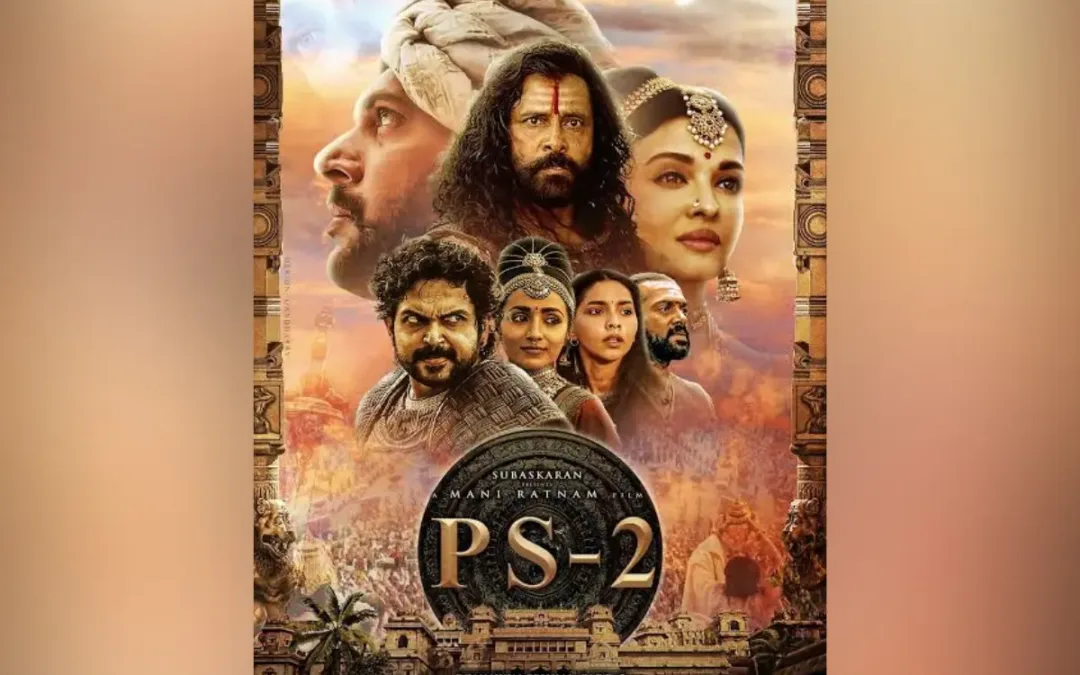Read in : தமிழ்
Tamil iconic writer Kalki’s historical fiction Ponniyin Selvan serialised in the Tamil magazine Kalki for three-and-half years in 1950s still retains its appeal for countless readers in Tamil Nadu. Drawing heavily on historical accounts of the Chola regime from the middle of the 9th to the 13th century, the novel focuses on sensational and exciting events in the last days of Sundara Chola, roughly covering the short period post-960 CE.
Out of the novel’s five parts, two have been filmed as PS-I and released last year, grossing rave reviews and revenue.
Now PS-II is set for release soon, filming the remaining three parts of the novel.
PS-II, following the novel, will have two major portions taking the lion’s share of the screen: 1. The circumstances, natural or human-made, leading to the murder of Adita Karikala. 2. The twists and turns over the succession of King Sundara Chola
The most intriguing and interesting segment of the novel is the mysterious murder of Adita Karikala, eldest son of Sundara Cholan, in the infamous Kadambur palace. In fact, PS-II, following the novel, will have two major portions taking the lion’s share of the screen: 1. The circumstances, natural or human-made, leading to the murder of Adita Karikala. 2. The twists and turns over the succession of King Sundara Chola.
As for the first major plot, Kalki himself did not reveal the suspense over the murder even when he ended the novel. Breaking the convention of a whodunit, he kept readers just guessing who the real culprit was.
Also Read: PS-1: Mani Ratnam lost in the Chola maze
In chapter 39 of the 5th and last part of his novel, Kalki presents the scene of the crime in a room in Kadambur palace owned by chieftain Sambuvarayar on a note of intrigue and suspense. The scene shows the main characters – Vandhiya Devan, Nandhini, Adita Karikala, Manimeghalai, daughter of Sambuvarayar, Nandhini’s husband Periya Pazhuvettaraiyar in the disguise of a Saivite (‘kalamugha saivar’) – as also Ravidasan wearing the mask of a tiger, and his acolytes, the conspirators from the Pandiya Kingdom (Pandiya ‘aabathu udhavigal’).
Instead of showing the actual scene of the culprit murdering Adita Karikalan, Kalki just shows the post-murder ambience where there are characters reacting emotionally. Leaving his vital characters in silhouette and leaving fragments of the scenes, Kalki deliberately and deftly kept the ending all the more intriguing, not pinpointing to anyone as the actual murderer. While Vandiya Thevan is charged with murder, Manimegalai is shown as crying aloud that it was she who murdered the prince in a moment of mental instability.
Adita Karikalan himself in his private dialogue with Nandhini accused her of conspiring to kill him and even cast a slur on his own brother Arulmozhi Varman, the protagonist of the novel, and his own sister Kundavai.
It seems that Kalki did not like to commit himself over the issue though there are historians such as Neelakanta Sastri who have pointed out that Madhurantaka (later Uthama Chola), cousin of king Sundara Chola, was the main conspirator in the murder, and historians such as T V Sadasiva Pandarathar who deny the role of Madhurantaka. But the Udayarkudi inscriptions and Thiruvalangadu copper plates which point to the role of the Pandiya conspirators, Ravidasan-Parameswaran brothers, who held the official post under the Madhurantaka regime.
Instead of showing the actual scene of the culprit murdering Adita Karikalan, Kalki just shows the post-murder ambience where there are characters reacting emotionally
Unlike Kalki, it was writer Balakumaran who clearly described a group of Brahmins led by Ravidasan as conspiring to kill Adita Karikalan to avenge the assassination of Pandya king Veerapandian. In his novel Kadigai (College), he gives a pen-portrait of the Brahmin warriors taking a murderous vow and training at the Kandalur martial art centre and of their sneaking into the Chola kingdom and executing the killing.
History says that Arulmozhi Varman (later Raja Raja Chola-I), who ascended the throne in 985 CE, invaded the famous Kandalur. There have been divided opinions on the invasion he undertook during his reign. Balakumaran drew on the school of thought that the murderers – Ravidasan, Parameswaran, Soman, Kirama Viththan – were long martially trained at the Kandalur centre before venturing to kill the Chola prince. The inscription concerned had this phrase describing Raja Raja Chola-I: ‘Kandalur Chalai Kalam Aruttu Aruli’ which had been interpreted by various scholars including the Tamil poet Kavimani Desika Vinayagam Pillai.
Also Read: Ponniyin Selvan movie: The strong story that Mani Ratnam films lacked
Coming back to Kalki’s novel, he obviously let his imagination have a free run in the characterisation of Madhurantaka and followed the cinematic template of his time – swap of newborns. Building up events slowly and steadily towards a climax that the readers are kept anticipating and then suddenly ending the whole narrative with an anti-climax that takes the readers by surprise, Kalki pulled off a tricky feat. In fact, that was the demand he had to fulfil to keep the novel’s tempo. So, no wonder, several top film personalities including the late matinee idol MGR had aspired to turn the novel into a film.
Now that the audience is set to be regaled with the PS-II, Mani Ratnam too will not dare to expose the real murderers of Adita Karikala.
What he will do at best is to just leave straws in the wind as Kalki had done.
Read in : தமிழ்











